m (Robot: Automated text replacement (-USS Enterprise (NCC-1701-D) +{{USS|Enterprise|NCC-1701-D|-D}} & -{{USS|Enterprise|NCC-1701-D}} +{{USS|Enterprise|NCC-1701-D|-D}} & -USS ''Enterprise'' (NCC-1701-D) +{{USS|Enterpr) |
m (Robot: Automated text replacement (-. +. )) Tag: apiedit |
||
| (96 intermediate revisions by 30 users not shown) | |||
| Line 1: | Line 1: | ||
| − | [[ |
+ | [[File:USS Enterprise in distant galaxy, remastered.jpg|thumb|The ''Enterprise''-D at the distant place]] |
| + | {{disambiguation|the event|Collapse of the universe}} |
||
| + | {{aquote|...the end of the universe? Or do you see this as the beginning of it?|Yvette Gessard-Picard|2364|Where No One Has Gone Before}} |
||
| + | The '''end of the universe''', '''where none have gone before''', and the '''outer rim''' were informal euphemisms used by [[Captain]] [[Jean-Luc Picard]] of the {{USS|Enterprise|NCC-1701-D|-D}} to describe an unknown area over one billion [[light year]]s away from the [[Milky Way Galaxy]]. As of the late [[24th century]], it stood as the furthest location in the [[universe]] reached by the [[Federation]]. ({{TNG|Where No One Has Gone Before}}) [[Lieutenant Commander]] [[Dexter Remmick]] called the location the '''edge of the universe'''. ({{TNG|Coming of Age}}) |
||
| ⚫ | After leaving the [[Triangulum Galaxy]], which was itself reached due to a mistake on [[the Traveler]]'s part during a [[warp engine]] experiment, another mistake caused the vessel to not only leave Triangulum, but arrive one billion light years away from the Milky Way. In the unknown area, unidentified objects of huge size, resembling transparent cubes with bright glowing corners, sped past the ship in groups with seemingly random patterns, in a blue [[nebula|nebulous]] background. |
||
| − | The '''end of the universe''', also known as '''where none have gone before''' or the '''outer rim''', was the informal name [[Jean-Luc Picard]] of the {{USS|Enterprise|NCC-1701-D|-D}} gave an unknown area one billion light years from the Milky Way. |
||
| + | The [[Brain|thoughts]], [[imagination]] and [[Engram|memories]] of the crew began to manifest as subjective or shared reality. [[Yvette Picard|Jean-Luc Picard's mother]], who came to Picard in a vision, suggested they might in fact be in the universe's [[Big Bang|beginning]], rather than end. The Traveler however explained that "thought" was in fact the basis of all reality and the essence of the area where they were. Such a situation was quickly recognized to be dangerous for anyone lacking sufficient intellectual control. ({{TNG|Where No One Has Gone Before}}) |
||
| ⚫ | After leaving the [[Triangulum Galaxy]], which was |
||
| + | {{bginfo|As of the 21st century, some [[quasar]]s have been charted at being anywhere between 780 million and 13 billion light years from [[Earth]].}} |
||
| − | In the area, phenomenon of huge size that look like snowflakes speed past. The background is a dark blue, possibly a [[nebula]] of some kind. The area can cause [[brain|thought]] to become reality, as experienced by the crew of the ''Enterprise''-D. Whatever they think actually becomes true. |
||
| + | [[Category:Regions]] |
||
| − | |||
| − | == Background == |
||
| − | |||
| − | The area, according to Picard, is at the "end of the universe." However, some [[quasar]]s have been charted at being between 780 million and 13 billion light years from [[Earth]], so by any standard the place the ''Enterprise'' arrived at was definitely ''not'' the end of the universe. In addition, many theories exist in quantum physics that space itself is curved, meaning that there really is no end of the universe. Other theories (among them the theories of [[Stephen Hawking (actor)|Stephen Hawking]]) put the edge of the universe at some 15 billion light years away in an area where expanding waves from the [[Big Bang]] are constantly forming into new matter. |
||
| − | |||
| − | Jean-Luc Picard's mother, who came to Picard in a vision, suggested they might be in the beginning of the universe. ({{TNG|Where No One Has Gone Before}}) |
||
| − | |||
| − | [[Category:Astronomical objects]] |
||
Revision as of 03:15, 4 April 2016

The Enterprise-D at the distant place
The end of the universe, where none have gone before, and the outer rim were informal euphemisms used by Captain Jean-Luc Picard of the USS Enterprise-D to describe an unknown area over one billion light years away from the Milky Way Galaxy. As of the late 24th century, it stood as the furthest location in the universe reached by the Federation. (TNG: "Where No One Has Gone Before") Lieutenant Commander Dexter Remmick called the location the edge of the universe. (TNG: "Coming of Age")
After leaving the Triangulum Galaxy, which was itself reached due to a mistake on the Traveler's part during a warp engine experiment, another mistake caused the vessel to not only leave Triangulum, but arrive one billion light years away from the Milky Way. In the unknown area, unidentified objects of huge size, resembling transparent cubes with bright glowing corners, sped past the ship in groups with seemingly random patterns, in a blue nebulous background.
The thoughts, imagination and memories of the crew began to manifest as subjective or shared reality. Jean-Luc Picard's mother, who came to Picard in a vision, suggested they might in fact be in the universe's beginning, rather than end. The Traveler however explained that "thought" was in fact the basis of all reality and the essence of the area where they were. Such a situation was quickly recognized to be dangerous for anyone lacking sufficient intellectual control. (TNG: "Where No One Has Gone Before")
